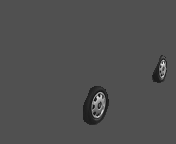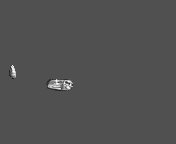 |
The term "blindsight" is normally used to describe the subconscious visual perception that has been found in some blind people: these blind people perform better than chance would predict when asked to point at visual events, although they have no conscious perception of light or sight. Brain scans appear to confirm that people with blindsight do not "fake" their lack of conscious visual perception.
On this page we take an unconventional literal interpretation of the term blindsight, taking it to mean perception of visual information by totally blind people through the use of artificially generated soundscapes. No blindsight in the conventional sense is required or involved here.
 |
Click the left wheels link to load a two-second MP3 stereo sound sample (37K) containing a view towards the front left of a parked car. From our viewpoint this means that the front of the car is ahead of us on our left, and the left side of the car is ahead of us on our right. We would thus bump into the front left edge of the car and touch its left head-light if we were to walk straight ahead.
The sound sample contains two soundscapes of one second each, a simple one in which everything except the two wheels of the left side of the car has been edited out, immediately followed by another far more complex soundscape for the photograph of the complete scene with the car and its visual background. By comparing the two soundscapes, you will hear precisely what sound parts in the extremely complicated second soundscape of the photograph correspond to the wheels. Learning to properly focus your auditory attention is the key to learning the language of vision substitution.
The front left wheel sounds more or less in the lower middle of the soundscape, and the rear left wheel sounds higher pitched on your right. The rear left wheel is somewhat further away and therefore also sounds "smaller" in the soundscape due to visual perspective. The rules of visual perspective are here the reason that the rear wheel sounds with a higher pitch: it shows at a higher position in the photograph.
 |
Can we hear out the front license plate too? Yes, sure we can! Just click the license plate link to load a MP3 stereo sound sample (37K) containing the same view but now highlighting the bright Dutch license plate instead of the wheels in one of the two soundscapes. So in this sample you hear the simple "license plate soundscape", where everything except the front license plate has been edited out, immediately followed again by the complex soundscape of the complete photograph. You should be able to hear out the license plate in both soundscapes, the simple one and the complex one.
 |
Can we hear out the two head-lights in the front of the car? Yes, although that is a bit harder. Click the head-lights link to load a MP3 stereo sound sample (37K) containing the same view but now highlighting the head-lights. In this sample you first hear a soundscape with the two head-lights, since everything except the head-lights has been edited out, immediately followed again by the complex soundscape of the complete photograph.
Note that we here speak of "head-lights" for short, although the head-lights are off and we are hearing the ambient light returned by the reflectors and their glass covers. From our viewpoint, the car's right head-light sounds on our far left, and the car's left head-light sounds somewhat lower pitched and closer to the middle of the soundscape. This second head-light sounds larger because it is closest to us and "facing" us (its surface perpendicular to our viewing direction), while the other light is a bit further away and not quite facing towards us. The pitch difference between the two lights is again the result of visual perspective.
Again you will find that focussing your attention on specific details of the soundscapes is hard, but when you manage to do it, here with the help of the simplified soundscapes, you can indeed hear many more and finer details than you might have believed or expected!
Make sure that your media player runs in autorepeat mode such that you can listen to each soundscape a number of times. With Microsoft Windows Media Player 9 and 10 you can toggle the repeat mode via Control T or via the menu Play | Repeat. With the older Microsoft Windows Media Player 6.4 you can go to the menu View | Options, select the Playback tab and then select "Repeat forever".
The soft background noise in the simple soundscapes is due to the uniform grey background that was used to fill up the visual background for the wheels, license plate and head-lights. Black would have given a silent background. Note for confused sighted readers trying to match the soundscapes to the corresponding animated .gif images on this page: the MP3 sound samples here run independently from the animated .gif's, so the animations will not run synchronized to the soundscapes.
The soundscapes were created using The vOICe for Windows, and afterwards the saved .wav files were converted into MP3 format to reduce the file size for downloading. Please keep in mind that it is not known how skilled blind people can get at soundscape interpretation.
More information about preservation of visual information is provided on the The vOICe to AIM page and the Information Preservation in Seeing with Sound page. Other MP3 sound samples can be found on the Visual Orientation for the Blind page, the Walk towards Fence page, the Hearing a Printed Graph page, the The vOICe of America page, the Planet Saturn page, the Access Symbol page and the Television for the Blind page.